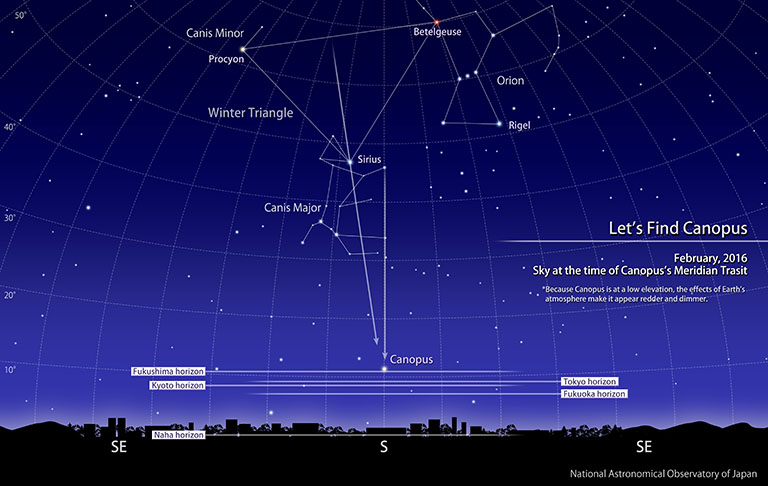Astronomical Events Information | 2016 | February
Let’s Find Canopus
A Chance to Observe Canopus!

This is a good time to see the 1st magnitude star Canopus in the constellation Carina.
Even at its maximum elevation, i.e. when it crosses the meridian, Canopus appears low in the sky, just above the horizon, when it is viewed from Japan (excluding northern Japan). From the viewpoint of northern Japan, Canopus never rises above the horizon so it can’t be seen. The farther south the viewing location is, the higher Canopus rises, making it easier to find.
The white, 1st magnitude star Canopus is the second brightest star in the entire sky. But because it is located low in the sky, the effects from the Earth’s atmosphere make it appear dimmer and redder.
To search for Canopus on a clear night, choose a location with an unobstructed view of the southern horizon and find Sirius in the Constellation Canis Major. (Sirius also serves as one of the vertices of the Great Winter Triangle.) From Sirius, look down towards the southern horizon to find Canopus.
| Location | Maximum Elevation | Time of Meridian Transit (Feb 1) | Time of Meridian Transit (Feb 11) | Time of Meridian Transit (Feb 21) |
|---|---|---|---|---|
| Naha | 11.2° | 22:09 | 21:30 | 20:50 |
| Fukuoka | 3.9° | 21:58 | 21:19 | 20:39 |
| Kyoto | 2.5° | 21:37 | 20:57 | 20:18 |
| Tokyo | 1.9° | 21:21 | 20:41 | 20:02 |
| Fukushima | 0.1° | 21:18 | 20:39 | 19:59 |
* The maximum elevations listed here include the effects of atmospheric refraction.
Reference: Ephemeris Computation Office
You can look up the rising and setting times for the Sun and the Moon, and the phases of the Moon in the “Koyomi Station” of the NAOJ Ephemeris Computation Office.
You can find the appearance of the Moon and planets as seen from a typical city under “Sky Viewer.”